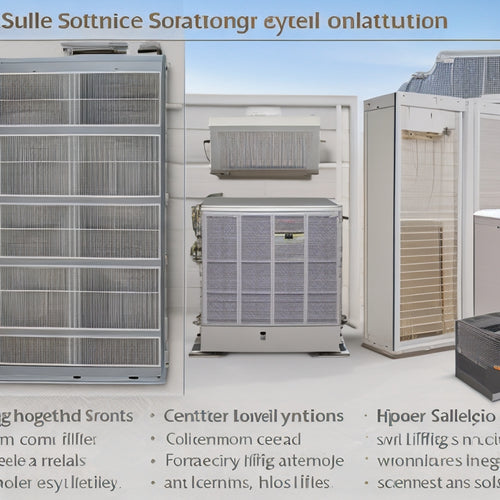
Eco-Friendly Wireless Peripherals: Reduce Your Office's Power Consumption
Share
As you work to reduce your office's power consumption, switching to eco-friendly wireless peripherals is a great place to start. With traditional devices greatly contributing to energy waste, making the switch can help you lower your electricity bills and support sustainable manufacturing practices. By opting for energy-efficient keyboards, mice, and other peripherals, you'll not only reduce your office's carbon footprint but also minimize electronic waste. With top brands offering eco-friendly options and strategies for optimizing energy consumption, you're on the right track to creating a more sustainable workspace - and there's more to investigate to make your office even greener.
Key Takeaways
- Switching to eco-friendly wireless peripherals can lower electricity bills and reduce power consumption in the office.
- Energy-efficient keyboards, mice, and speakers minimize energy waste and support sustainable manufacturing practices.
- Look for wireless peripherals with power-saving features like auto-sleep and manual switches to reduce unnecessary energy use.
- Eco-friendly wireless peripherals can help reduce greenhouse gas emissions and support climate action in the office.
- Rechargeable batteries and sustainable materials in wireless peripherals minimize disposable battery waste and electronic waste.
Benefits of Energy-Efficient Peripherals
Nearly 90% of computer users spend at least eight hours a day working on their devices, resulting in a considerable amount of energy consumption. By switching to energy-efficient peripherals, you can greatly reduce your office's power consumption.
Not only do eco-friendly peripherals reduce energy waste, but they're also designed with sustainable manufacturing processes and built with long-lasting materials. This means you'll be reducing electronic waste and supporting environmentally responsible practices.
Furthermore, energy-efficient peripherals can help you save money on your electricity bill, giving you more freedom to allocate your resources as you see fit.
In addition, optimizing your office's energy consumption can be achieved by implementing strategies like selecting energy-efficient charging equipment and leveraging government incentives for sustainable projects.
Low-Energy Wireless Keyboard Options
Investigate the latest advancements in wireless keyboard technology, and you'll find a plethora of low-energy options designed to reduce your office's carbon footprint.
You can opt for mechanical keyboards with wireless connectivity, which consume considerably less power than traditional keyboards. Many companies are now incorporating solar-powered charging solutions into their devices, allowing for a considerable reduction in energy waste.
Look for keyboards with power-saving features like auto-sleep or manual on/off switches to minimize energy waste. Some models even use rechargeable batteries or solar power, eliminating the need for disposable batteries.
When selecting a low-energy wireless keyboard, consider factors like battery life, range, and compatibility to guarantee seamless integration with your office setup.
Eco-Friendly Wireless Mouse Solutions
Eco-Friendly Wireless Mouse Solutions
In tandem with low-energy wireless keyboards, eco-friendly wireless mouse solutions have emerged as an essential component of sustainable office setups. As you shift towards a more environmentally friendly workspace, consider the following eco-friendly wireless mouse solutions: Opting for energy-efficient peripherals can greatly reduce greenhouse gas emissions renewable energy solutions and support climate action.
In addition, incorporating sustainable practices in your office can enhance your brand reputation and attract environmentally conscious customers.
-
Ergonomic design: Opt for mice with ergonomic design that promote comfort and reduce strain on your hand and wrist, allowing you to work for extended periods.
-
Rechargeable batteries: Choose mice with rechargeable batteries that can be easily charged via USB, reducing the need for disposable batteries and minimizing electronic waste.
-
Energy-efficient sensors: Look for mice with energy-efficient sensors that consume less power while maintaining high accuracy and precision.
- Sustainable materials: Select mice made from sustainable materials, such as recycled plastics or bioplastics, that reduce the carbon footprint of your office.
Power Consumption of Traditional Devices
When you use traditional wireless peripherals, you're likely powering energy-hungry devices that consume a significant amount of energy.
Additionally, these devices often continue to drain power even when they're idle, which can be a significant contributor to your overall energy bill.
It's crucial to reflect on the environmental impact of our daily habits, such as reducing carbon footprint, and adopt sustainable practices to minimize our ecological footprint.
Energy Hungry Devices
Many traditional wireless peripherals guzzle energy, contributing greatly to your overall power consumption. You might be surprised at how much energy these devices consume, especially when you're not using them. This excessive energy consumption not only increases your electricity bill but also reduces device longevity.
Additionally, adopting sustainable practices in fleet management, such as transitioning to green vehicles, can markedly reduce emissions and operating costs. By implementing green fleet management strategies, companies can minimize their carbon footprint and promote eco-friendly practices.
Here's a breakdown of the energy consumption of traditional wireless peripherals:
- Wireless keyboards: These devices can consume up to 20mA of power, even when idle.
- Wireless mice: They can draw up to 15mA of power when not in use.
- Wireless speakers: These devices can consume up to 50mA of power when turned off but still plugged in.
- Wireless printers: They can use up to 100mA of power when in standby mode.
Idle Power Drain
Beyond their obvious energy drain during use, traditional wireless peripherals are notorious for their idle power consumption, silently siphoning power from your outlets even when turned off or in standby mode.
This idle energy can add up quickly, contributing to your office's overall power consumption. You may think you're saving energy by putting devices in standby, but many traditional peripherals continue to draw power when not in use.
Effective power management is key to reducing idle power drain. Look for eco-friendly wireless peripherals with built-in power-saving features, such as automatic shut-off or low-power standby modes.
Environmental Impact of E-Waste
When you upgrade to a new wireless peripheral, what happens to your old device?
You're likely contributing to the growing problem of electronic waste, or e-waste, which can lead to toxic chemical leaks and permanent damage to the environment.
As you consider your next tech purchase, it's crucial to think about the long-term consequences of your actions, including the potential for landfill waste growth.
Toxic Chemical Leaks
By the time electronic waste reaches landfills, toxic chemicals have already begun to seep into the environment.
You're likely aware that e-waste contains hazardous materials like lead, mercury, and cadmium. When these chemicals leak into the environment, they can contaminate soil and water, leading to toxic exposure and threatening chemical safety.
Here's what you need to know about toxic chemical leaks:
-
Soil contamination: Toxic chemicals can seep into the soil, affecting plant growth and potentially entering the food chain.
-
Water pollution: Chemicals can leak into groundwater, posing a risk to human health and wildlife.
-
Air pollution: When e-waste is burned or incinerated, toxic chemicals are released into the air, contributing to air pollution.
- Health risks: Exposure to these chemicals has been linked to health problems, including cancer, birth defects, and neurological damage.
It's essential to evaluate the environmental impact of e-waste and take steps to reduce your office's contribution to this growing problem.
Landfill Waste Growth
You're likely generating more e-waste than you realize, and it's contributing to a staggering problem: landfill waste growth. Electronic waste, or e-waste, is the fastest-growing waste stream globally, with only 20% being properly recycled. The remaining 80% ends up in landfills, where toxic chemicals and heavy metals can leach into the soil and water, harming the environment and human health.
| Year | E-Waste Generation (Million Metric Tons) |
|---|---|
| 2014 | 41.8 |
| 2016 | 44.7 |
| 2018 | 50.0 |
| 2020 | 53.6 |
| 2025 (projected) | 73.1 |
Implementing landfill avoidance strategies and recycling programs can help mitigate this issue. By adopting eco-friendly wireless peripherals and responsibly disposing of e-waste, you can contribute to a cleaner, healthier environment and promote a culture of sustainability.
Top Brands for Sustainable Peripherals
Among the plethora of wireless peripheral brands vying for your attention, a select few stand out for their commitment to sustainability.
You're in luck because we've got the scoop on the top brands that are making a positive impact on the environment.
Here are the top brands leading the charge in sustainable peripherals:
-
Logitech: Known for using sustainable materials in their products and holding certifications like ISO 14001 for environmental management.
-
Dell: Offers a range of eco-friendly peripherals made from recycled materials and boasts a strong commitment to reducing e-waste.
-
HP: Incorporates sustainable materials into their products and has achieved certifications like EPEAT and ENERGY STAR.
- Microsoft: Designs peripherals with recyclable materials and holds certifications like ISO 14001, demonstrating their dedication to environmental responsibility.
These brands are setting the stage for a more sustainable future, and you can join the movement by choosing their eco-friendly wireless peripherals.
Making the Switch to Green Tech
Five simple steps can help you shift to eco-friendly wireless peripherals and reduce your carbon footprint. Start by identifying areas where you can replace traditional peripherals with green alternatives. Next, research and compare different green technology options, considering factors like energy efficiency and recyclability. Then, make a plan to phase out old devices and replace them with sustainable ones. Implement your plan, and finally, monitor and adjust your progress to guarantee you're meeting your sustainability goals.
| Step | Action | Benefit |
|---|---|---|
| 1. Identify | Replace traditional peripherals | Reduce energy consumption |
| 2. Research | Compare green technology options | Make informed purchasing decisions |
| 3. Plan | Phase out old devices | Minimize e-waste generation |
Frequently Asked Questions
Can I Use Eco-Friendly Peripherals With My Existing Computer Setup?
You're the skilled conductor, orchestrating a harmonious tech arrangement; now, can you swap in eco-friendly instruments? Yes, you can, but first, consider compatibility concerns and potential setup adjustments to guarantee a seamless performance with your existing computer setup.
Are Energy-Efficient Peripherals More Expensive Than Traditional Ones?
When comparing costs, you'll find that energy-efficient peripherals might be pricier upfront, but they'll save you money in the long run through reduced power consumption, making them a worthwhile investment for your wallet and the planet.
Do Wireless Peripherals Really Make a Significant Environmental Impact?
You might be surprised to learn that idle electronics waste enough energy to power 80,000 homes annually. By switching to wireless peripherals, you'll not only reduce e-waste but also unfasten significant sustainability benefits, as wireless technology streamlines energy consumption.
Can I Recycle My Old Peripherals Responsibly?
When you're ready to dispose of old peripherals, you can recycle them responsibly through manufacturer-led programs or local recycling centers that accept electronic waste, ensuring environmentally responsible peripheral disposal.
Will Switching to Green Tech Affect My Device's Performance?
When you switch to green tech, you're likely to notice a negligible impact on performance, but you'll enjoy a potential enhancement in device longevity, making it a worthwhile trade-off for the eco-conscious freedom seeker like you.
Related Posts
-

Why Solar HVAC Filters Revolutionize Home Energy Efficiency
By adopting solar HVAC filters, you're shifting your home's energy reliance from fossil fuels to clean, renewable sou...
-

What Tax Deductions Apply to Sustainable Building Materials?
You can claim various tax deductions for sustainable building materials, thanks to over 40 federal tax incentives sup...
-

3 Earth-Loving Furniture Tips for Energy-Smart Homes
When furnishing your energy-smart home, you have the power to reduce your carbon footprint greatly by making consciou...


